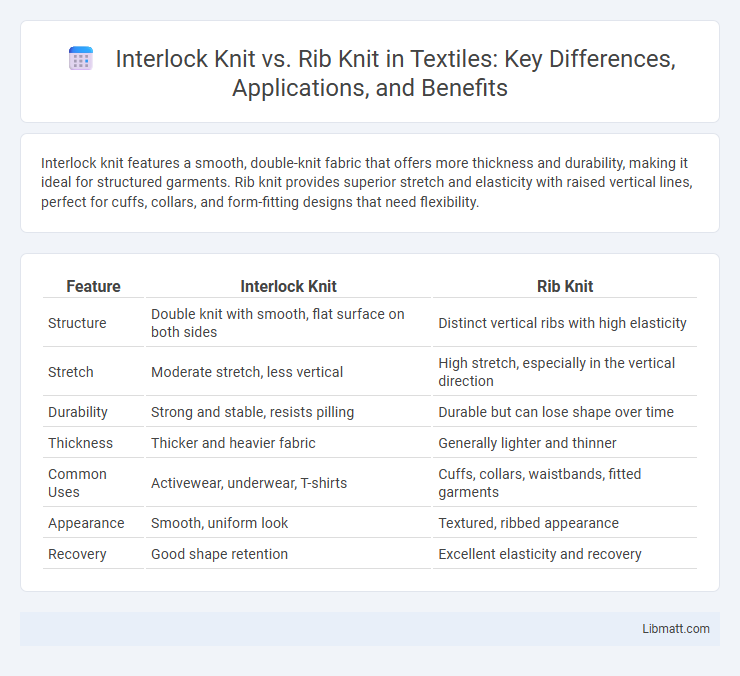Interlock knit features a smooth, double-knit fabric that offers more thickness and durability, making it ideal for structured garments. Rib knit provides superior stretch and elasticity with raised vertical lines, perfect for cuffs, collars, and form-fitting designs that need flexibility.
Table of Comparison
| Feature | Interlock Knit | Rib Knit |
|---|---|---|
| Structure | Double knit with smooth, flat surface on both sides | Distinct vertical ribs with high elasticity |
| Stretch | Moderate stretch, less vertical | High stretch, especially in the vertical direction |
| Durability | Strong and stable, resists pilling | Durable but can lose shape over time |
| Thickness | Thicker and heavier fabric | Generally lighter and thinner |
| Common Uses | Activewear, underwear, T-shirts | Cuffs, collars, waistbands, fitted garments |
| Appearance | Smooth, uniform look | Textured, ribbed appearance |
| Recovery | Good shape retention | Excellent elasticity and recovery |
Introduction to Interlock Knit and Rib Knit
Interlock knit features two layers of fabric knitted together, creating a smooth, durable, and stable textile ideal for activewear and baby clothes. Rib knit displays a distinctive vertical rib pattern, offering excellent elasticity and stretch, commonly used in cuffs, collars, and fitted garments. Both fabrics are popular in apparel manufacturing but differ significantly in texture, stretch recovery, and structural integrity.
Key Differences Between Interlock Knit and Rib Knit
Interlock knit features a smooth, tightly woven surface on both sides, offering greater stability and less stretch compared to rib knit, which has a distinct vertical rib pattern with excellent elasticity due to its alternating knit and purl stitches. Rib knit is highly flexible, recovering well from stretching, making it ideal for cuffs and collars, while interlock knit provides a thicker, more insulating fabric preferred for structured garments. The key difference lies in their construction: interlock knit uses two layers of jersey knit combined, whereas rib knit alternates knit and purl stitches in columns for enhanced stretch and texture.
Structure and Construction of Interlock Knit
Interlock knit features a tightly woven structure with two layers of fabric intermeshed, creating a smooth surface on both sides and enhanced thickness compared to rib knit. This construction provides superior stability, reduced stretch, and better durability, making it ideal for garments requiring a polished look and firm shape retention. Your choice of interlock knit ensures a soft texture with excellent resistance to curling and warping, distinguishing it from the more elastic and textured rib knit.
Structure and Construction of Rib Knit
Rib knit features a distinctive vertical rib pattern created by alternating knit and purl stitches, resulting in a fabric with excellent elasticity and a textured surface. Its structure consists of interlocking loops on both sides, which enhances stretch recovery and provides a snug fit. This construction makes rib knit ideal for cuffs, collars, and form-fitting garments due to its ability to retain shape and offer superior flexibility.
Fabric Stretch and Recovery: Interlock vs Rib
Interlock knit fabric offers moderate stretch with excellent recovery, making it ideal for garments that require smooth, stable structure without excessive elasticity. Rib knit fabric provides superior stretch and superior recovery, especially in widthwise direction, which makes it perfect for cuffs, collars, and form-fitting clothing that needs to retain shape after substantial stretching. Understanding the differences in stretch and recovery between interlock and rib knits can help you choose the right fabric for durable, comfortable wear.
Softness and Comfort: Comparative Analysis
Interlock knit fabric is characterized by a smooth, dense texture that offers superior softness and a gentle feel against the skin, making it ideal for sensitive areas and prolonged wear. Rib knit, with its raised vertical ridges, provides excellent stretch and recovery, enhancing comfort through flexibility but may feel slightly coarser compared to interlock knit. Your choice between these fabrics should consider the balance between softness and elasticity depending on the intended garment use, with interlock knit excelling in softness and rib knit delivering better adaptability.
Durability and Wear Resistance
Interlock knit offers superior durability and wear resistance due to its tightly woven, double-layer construction, making it less prone to stretching and pilling compared to rib knit. Rib knit, while more flexible and elastic, tends to wear out faster under frequent strain and repeated washing. Your choice between the two should consider long-term fabric resilience, especially for garments subjected to heavy use.
Common Uses in Fashion and Apparel
Interlock knit is widely used in fashion for creating smooth, stable garments like t-shirts, dresses, and activewear due to its thick, durable, and stretchy nature. Rib knit is preferred for cuffs, collars, and fitted garments because of its excellent elasticity and ability to maintain shape over time. Your choice between interlock knit and rib knit will impact the garment's fit, comfort, and style versatility.
Care and Maintenance Tips
Interlock knit fabrics require gentle washing with cold water and mild detergent to maintain their smooth texture and prevent shrinking, while rib knit materials benefit from hand washing or using the delicate cycle to preserve elasticity. Avoid high heat when drying both types; air drying is recommended for longest garment life, with rib knits particularly prone to losing shape under intense heat. Your careful attention to washing and drying techniques ensures these knit fabrics retain their durability and comfort over time.
Choosing the Right Knit for Your Project
Interlock knit offers a smooth, stable fabric ideal for apparel requiring durability and a clean finish, such as activewear and baby clothes, while rib knit provides exceptional stretch and recovery, perfect for cuffs, collars, and fitted garments. Selecting the right knit depends on the desired elasticity, texture, and garment structure--interlock delivers a firmer, double-knit fabric, whereas rib knit features vertical ribbing that enhances flexibility. Understanding these characteristics ensures optimal fabric performance and comfort tailored to the specific needs of your sewing project.
Interlock knit vs Rib knit Infographic

 libmatt.com
libmatt.com